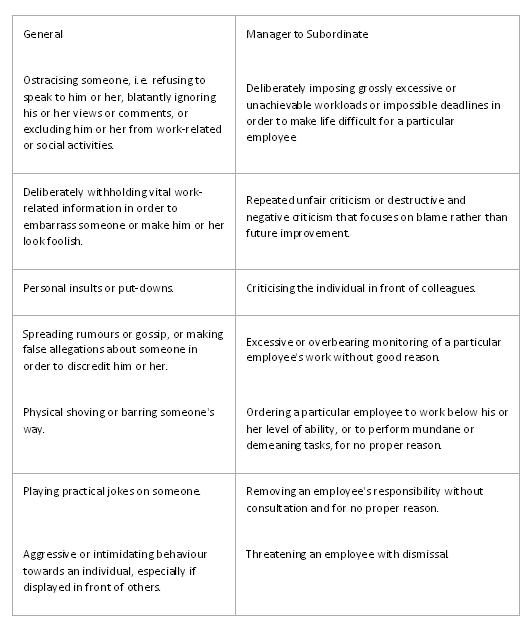We all want to create a working environment in which our employees look forward to spending time and where they will be their most productive. But sometimes it can go wrong and people find that they have to work somewhere they might feel unhappy, degraded or even humiliated. The creation of an offensive work environment is to be avoided at all costs, if your employees are to remain happy and healthy.
The phrase “creating an intimidating, hostile, degrading, humiliating or offensive environment” means that behaviour can amount to harassment even if it is not targeted at an individual. It will be enough that the behaviour creates an atmosphere at work that causes offence to a particular employee, or makes them feel uncomfortable. For example, the circulation of sexually explicit material around an office, even though it might not be targeted at a particular employee, could constitute sexual harassment against any woman or man who found it distasteful.
Harassment can be physical, verbal or non-verbal and a wide range of different types of behaviour at work may potentially be perceived as harassment. This rather long list gives you some examples of behaviour that could be perceived as harassment:
- Sex-related harassment
- Telling jokes about women
- Making derogatory sexist remarks
- Deliberately placing tools or materials that a woman needs to do her job on a high shelf to make it harder for her to reach them
- Harassment of a sexual nature
- The display of sexually explicit material on computer screens or in calendars
- Leering at a woman in a manner that is overtly sexual
- Physically touching someone in a sexual manner where such conduct is not welcome
- Remarks, banter or jokes of a sexual nature
- Making sexual suggestions or persisting with sexual advances after it has been made clear that such approaches are unwelcome
- Gender reassignment harassment
- Calling someone a nickname linked to the fact that he or she has undergone gender reassignment
- Inappropriate touching designed to check whether or not an individual has undergone reconstructive surgery
- Leaving items specifically associated with the individual’s old or new gender on their desk
- Racial harassment
- Calling someone a nickname linked to their skin colour or nationality
- Remarks, banter or jokes about people from different racial backgrounds
- Disability harassment
- Using insulting terminology when referring to a disabled colleague
- Excessive staring, for example at someone with a facial disfigurement
- Mimicking a disabled colleague’s mannerisms or speech
- Religious harassment
- Remarks, banter or jokes about particular religious beliefs or religious practices
- Derogatory remarks made about a particular item of clothing or jewellery worn by someone as a symbol of their religion
- Sexual orientation harassment
- Deliberate isolation of someone on grounds of their sexuality or perceived sexuality
- Deliberately behaving in an effeminate manner in the presence of someone who is gay
- Calling someone a nickname based on his or her sexuality or perceived sexuality
- Age harassment
- Banter and jokes that make fun of older people or demean their abilities
- Calling someone a name linked to their age
- Ignoring someone, or treating their views as worthless, just because they are younger or older than other employees
How do you guard against offensive jokes, banter and remarks?
General banter linked to sex, race, religion, sexual orientation or age is the most common form of harassment in employment. Managers should make sure that they properly brief all their staff as to the types of conduct and speech that might cause offence to others and make it clear that such behaviour will be unacceptable.
The basic rule should be that any jokes, remarks or banter that might cause offence to another employee on any grounds will not be permitted. Employees should be encouraged to realise that their colleagues will have differing views and feelings and differing levels of sensitivity about certain matters.
In addition, no individual employee can ever know everything about their colleagues – who they are married to or any family issues that might mean that offence will be caused by inappropriate remarks. It should be a requirement in every department that employees treat their colleagues with dignity and respect and refrain from any behaviour that might cause offence.
Are you worried about the environment in which your staff work? Do you need help creating the most productive environment possible? Call me on 0118 940 3032 or email me here and we can talk about how I can help you to do this.
Source: XpertHR


 On the first day of Christmas, my HR Consultant gave to me, a Contract in a pear tree. Make sure that you have up to date contracts for all your employees.
On the first day of Christmas, my HR Consultant gave to me, a Contract in a pear tree. Make sure that you have up to date contracts for all your employees.
 On the third day of Christmas, my HR Consultant gave to me, three French Hens. If you have employees from Europe, keep an eye on our
On the third day of Christmas, my HR Consultant gave to me, three French Hens. If you have employees from Europe, keep an eye on our  On the fourth day of Christmas, my HR Consultant gave to me, four dreaded words. “You have been fired!” Before you rush to sack anyone, check to make sure you have a good reason and
On the fourth day of Christmas, my HR Consultant gave to me, four dreaded words. “You have been fired!” Before you rush to sack anyone, check to make sure you have a good reason and 

 On the seventh day of Christmas, my HR Consultant gave to me, seven swans-a-swimming. If, like a swan, you’re all grace and elegance above water, while below you’re frantically paddling to keep afloat of all things HR, just get in touch to see how we can help.
On the seventh day of Christmas, my HR Consultant gave to me, seven swans-a-swimming. If, like a swan, you’re all grace and elegance above water, while below you’re frantically paddling to keep afloat of all things HR, just get in touch to see how we can help.
 On the ninth day of Christmas, my HR Consultant gave to me, nine ladies dancing. And the men can dance too!
On the ninth day of Christmas, my HR Consultant gave to me, nine ladies dancing. And the men can dance too! On the tenth day of Christmas, my HR Consultant gave to me, ten lords (and ladies) leaping at the Christmas party. Make sure you lay down a few rules for proper behaviour, so that things don’t get out of hand.
On the tenth day of Christmas, my HR Consultant gave to me, ten lords (and ladies) leaping at the Christmas party. Make sure you lay down a few rules for proper behaviour, so that things don’t get out of hand. On the eleventh day of Christmas, my HR Consultant gave to me, eleven pipers piping. Make a big noise when your staff do a great job.
On the eleventh day of Christmas, my HR Consultant gave to me, eleven pipers piping. Make a big noise when your staff do a great job.  On the twelfth day of Christmas, my HR Consultant gave to me, twelve drummers drumming. I keep drumming good HR practices into my clients’ businesses, to help them grow successful companies that are great places to work.
On the twelfth day of Christmas, my HR Consultant gave to me, twelve drummers drumming. I keep drumming good HR practices into my clients’ businesses, to help them grow successful companies that are great places to work.